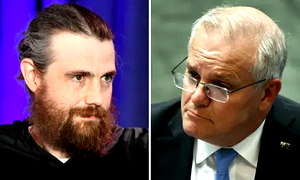
|
But what if extreme weather conditions start to become a trend and continue to have an effect on the game we love?
The AFLW is a prime example of the need to have courageous conversations around weather and welfare. Scheduled in the middle of summer, players are expected to play in extreme heat week after week.
Across the February Round 6 fixture St Kilda and Brisbane played in 34-degree conditions in Melbourne and the Adelaide Crows and Western Bulldogs match reached a temperature of 33 degrees in Adelaide.
The recent Round 7 match between West Coast and Richmond was played in mid-afternoon 37-degree conditions in Perth.
Contentiously the league has decided against changing the starting time of the games to offer players respite from the heat and has instead used their heat policy to encourage teams to employ extra water carriers and have water mist fans on the sidelines. The halftime break was extended for the Round 7 match by just four minutes.
For a league that prides itself on sports science and the health and wellbeing of its players, this stands in stark contrast.
Many may argue these conditions are simply the by-product of playing in the middle of the day in summer, but alarming statistics suggest the hot and dry conditions are here to stay.
Released in 2020 by CSIRO and the Bureau of Meteorology, the State of the Climate report found key trends of “continued warming of Australia’s climate.”
A Climate Council report ascertained that nine out of ten of the hottest years in Australia have occurred since 2005, and the Intergovernmental Panel on Climate Change (IPCC) research found that “Australia is one of the most vulnerable developed countries to the impacts of climate change”.
While the AFL and AFLW may be a victim of the consequences of climate change, it can’t neglect the fact that it is also a contributor.
The league’s corporate partners include mining magnates BHP, historically one of Australia’s largest emitting companies;
Toyota, whose parent company, Toyota Motor Corporation, was earlier this year fined US$180 million (A$250 million) for breaching emissions-reporting requirements; and Virgin Australia, whose jet fuel usage has a significant environmental impact.
Next season the AFLW will expand, with Essendon, Hawthorn, Port Adelaide, and the Sydney Swans all adding teams to the league.
With five states represented as well as the Kangaroos playing games in Tasmania, travel is an imperative part of the national competition but also leaves the largest carbon footprint.
AFL To their credit, a group of players are taking action.
Last year a union of players formed the AFL Players for Climate Action (AFLP4CA) movement. Co-founded by North Melbourne’s Tom Campbell and former teammate Jasper Pittard, more than 260 past and present AFL and AFLW footballers have already signed up.
“We’ve heard so many stories from around the country. Training relocated due to bushfire smoke. Regional clubs facing closure due to rising insurance premiums in flood and fire-prone areas. Grounds so hard during prolonged droughts they’re leading to increased injury,” the group tweeted.
“As footballers, we want to play our part in tackling climate change. We know Australia stands to benefit from strong climate action. We want to be part of building that future.”
If football is a game of one-percenters, then taking proactive environmental steps is the bare minimum the AFL Commission can do not just for the welfare of the players but for the planet and future generations.
With the highest spectator attendance and television audience of all sports in the country, it has a responsibility to lead by example before it’s too late.
Links
- (AU The Guardian) ‘We All Have A Role’: More Than 260 Australian Rules Footballers Sign Up To Climate Campaign
- (AU The Conversation) Time For A Reckoning: Cricket Australia, Fossil Fuel Sponsorship And Climate Change
- (AU ABC) Climate Change Threatens Future Of Winter Olympics And All Snow Sports, Research Suggests
- (AU The Guardian) David Pocock Leads 250 High-Profile Australian Athletes In Climate Campaign
- Major Climate Polluters Accused Of Greenwashing With Sport
- (AU) Sport Set To Reckon With Impacts Of Climate Change, And Encouraged To Act Now
- (AU) Game, Set, Match: Calling Time On Climate Inaction





